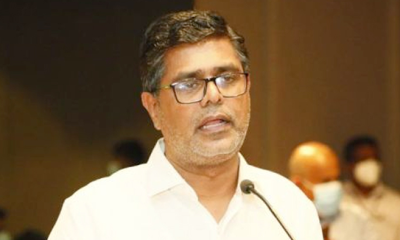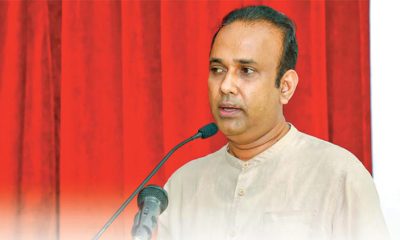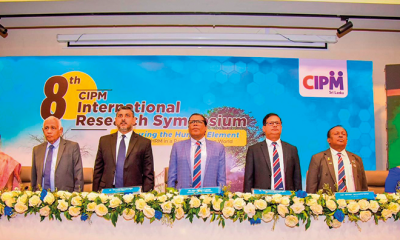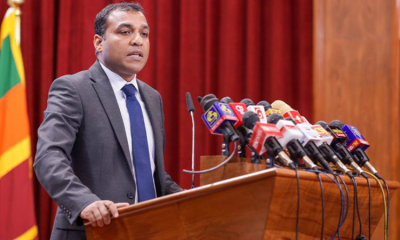Features
The Tightrope Walk on Decentralised Finance and Cryptocurrencies

By Charith Gamage
Cryptocurrencies together with Decentralised Finance (DeFi), the finance ecosystem that extends cryptocurrencies into banking territory, can positively impact developing countries. But it is not quite so straightforward and is still a double-edged sword for developing markets like Sri Lanka. So, how should the country position itself to face the key challenges ahead?
Since its inception following the Global Financial Crisis in 2007-2008, as an alternate digital asset, cryptocurrency has always been a two-edged sword, abundantly subjected to scepticism.
Some of this scepticism has a rationale behind it. Cryptocurrencies do not have an underlying cash flow, such as that for stocks of firms, nor do they have an inherent material value, such as for assets like gold. Being located inches away from the regulatory radar, they can also be equally prone to criminal activities. If that is not enough, bitcoin mining, the process by which new transactions are validated on the network, consumes a lot of energy. So, despite being a crypto enthusiast, even billionaire Elon Musk once stated, it has an environmental impact, too [1].
In the face of these challenges, the recent cryptocurrency price surge with the Covid-19 Pandemic has taken many by surprise. What caused the market to embrace them, spearheaded by its most popular type, Bitcoin’s spiralling 600%+ rally? According to crypto proponents, the value stems primarily from its design that can self-sustain as an alternative decentralised system to the traditional systems. In other words, the market is ready to pay the price for its ability to function as an asset over which no centralised person or authority has control. So, the claim, as the pandemic engulfed global economies, is that investors may have lost faith in central bank policies and their pursuit for an alternate asset that has resulted in this price movement.
DeFi, on the other hand, extends this concept and allows cryptocurrencies to function in a decentralised banking environment that may even have immense benefits to developing countries. As the debate continues, it is worth finding out more on the recent emergence of DeFi; how could it unlock the potential of Emerging/Frontier markets, and at what cost? What are the key hurdles to pull the meat from the bone moving forward?
What is DeFi, and how does it work?
The idea of DeFi is more broad-based than one of its workhorses, cryptocurrencies, which most are familiar with as a medium of exchange or store of value, and it builds on a fundamental structure known as the blockchain. The system allows it to operate without the need for intermediaries, such as traditional financial institutions like conventional commercial banks, brokerages, and of course, authorities such as central banks. However, it has its own ecosystem that recreates the traditional financial system. So, it is logical to say that DeFi refers to the decentralised banking and financial system that the technology is based on and includes components such as lending and borrowing services for cryptocurrencies (and many more). To put it simply, it is an alternative banking system in the digital space with digital currencies that has no middlemen (such as commercial or central banks who have controlling power) and with rules that are already written into it. Today, it mostly runs on the Ethereum blockchain, the second most popular currency after Bitcoin. DeFi has rapidly evolved in recent years, and, for example, Aave, Marker, and Curve Finance are the biggest lending systems in this space, with the sum of all assets deposited in DeFi closer to 45 billion USD [2].
Without banks or lawyers, as in the traditional financial system, DeFi is built with smart contracts, a self-executing contract built on the blockchain when predetermined conditions are met, and allows economic agents such as the general public and firms to engage in banking activities.
Because this architecture differs fundamentally from bringing the same traditional banking into the digital space, as happens in online banking, many can see that it will benefit developing countries when traditional financial systems fall apart. Nevertheless, it comes at a cost, where the country needs to overcome challenges to harness its potential.
Why exploring DeFi is pronounced in emerging and developing markets
It is not a secret that the lack of financial intermediation in the developing world under the conventional system hinders their economic potential. Although Sri Lanka’s unbanked population (26%) is somewhat lower than the global average (31%), it is unclear how certain groups’ failure to conform to formal regulations and paperwork around these institutions distances them from the entire expected services they desire (Data Source Findex 2017). On the other hand, economic agents have fewer investment opportunities to invest their wealth for a better return in economies with underdeveloped markets. DeFi seems to have better answers to those questions.
For example, a UNICEF project shows that DeFi can uplift those lives [3]. The project, Satchel, a Blockchain-based DeFi service created by a research group from Berkeley, helps fulfil the financial needs of those underprivileged communities by allowing them to pool their funds together and earn interest. The concept could be extended to pool their money and lend it out to small businesses; in this way, the community can use the interest earned for their purposes while the local small businesses fulfil their funding needs. So, DeFi can thus give an alternative, if not more than that, to regular banking, for small businesses and communities in rural regions, even if they are unable to satisfy the criteria of traditional banking.
Apart from improving financial inclusion among rural communities, DeFi clearly has other benefits with proper education, such as an efficient cross-border fund transfer for businesses and remittances. Sending remittance through cryptocurrency can gain more attention in the future as a low-cost solution for ordinary remittance transfers and currency conversions that can eat up as much as 7% of those flows. Also, DeFi can be easily integrated with the Universal Basic Income (UBI) programmes discussed in a previous article that empower low-income communities to lead the economy[4].
Most importantly, decentralisation allows the market to gain alternative power over the ability of traditional institutions to control the market by devaluing or increasing the money supply or by imposing unhealthy regulations on certain sectors. This balance could be healthy for the economy as it brings competition to the market over the conventional institutions.
What are the key challenges to be solved?
Although DeFi has the potential to boost economic activities, proper integration with society needs much more effort, including the development of digital infrastructure and literacy. A recent Daily FT editorial highlighted this challenge, citing that digitisation efforts will not be fruitful unless the underlying foundation is strengthened [5].
In addition, the emergence of an alternate banking system via DeFi can cause unprecedented challenges to economies. Of course, it can create “systemic risks” and propagate instabilities in conventional financial systems, depending on how interlaced they are. Having dominated the conventional monetary system, they can also lessen the effectiveness of the monetary tools and power of the institutions such as central banks. Although these discussions are still rudimentary, given that economics related to DeFi have not been tested at scale, they will be more hot topics as the technology grows.
On the other hand, DeFi regulation is one of the most daunting tasks, as exemplified by the experiences of many countries that are currently trying to combat it. At the moment, bringing capital gain income from crypto assets under the tax net, regulating crypto exchanges to avoid the misuse of technology, and curbing phoney cryptocurrency schemes, are the most popular topics in this space. Meanwhile, a Forbes article, citing an expert report by Chainalysis, shows that crypto in criminal activities is not as large as commonly believed [6]. While this fraction was deficient, 2.1% in 2019 and 0.34% in 2020 out of the total transaction volume, the article shows that the traditional non-crypto methods may still facilitate illicit activities much more frequently than these methods. Although this is a positive indication for authorities to welcome the technology, there is no guarantee that they would be exacerbated in the developing nations with relatively weaker institutions once popularised. With that being said, the overregulation approach may not be the best answer, but the easiest and costliest approach that wipes out complete benefits in the dash for DeFi.
The Way Forward
Despite the debate around cryptocurrency, the decentralised currency together with DeFi, the alternate decentralised financial system, undoubtedly can cause a significant impact on the developing world to increase the productivity of those economies. In particular, it is more pronounced to allow financial intermediation for those who found refuge under the conventional system for various reasons. It has gone mainstream now on Wall Street while top-level universities and researchers are involved in the development, despite all chaos surrounding cryptocurrency. More importantly, the underlying technology, blockchain, is considered one of the most promising emerging technologies at the moment.
From the Sri Lankan perspective, now it seems the government insists on looking deeply at the crypto and blockchain space[7]. This initiative is a positive sign and, if successful, will be a good foundation for exploring the ecosystem, DeFi, more broadly and carefully for better policies.
Not to mention, diving down the rabbit hole of DeFi requires a cohesive approach strengthening the digital infrastructure, facilitating a healthy Conventional-DeFi integrated ecosystem, hunting for policy instruments to combat the knock-on effects, and establishing a healthy and supportive regulatory framework. So, it will help the country shape the landscape to stay on par with the peer trading partners trying to reap the full potential of the technology under a controlled environment, and, of course, without blindly embracing it nor throwing out the baby with the bathwater.
The writer, a former Senior Assistant Director of the Central Bank of Sri Lanka, is a PhD candidate attached to the Monash University, Australia. He pursued his undergraduate studies in Engineering from the University of Moratuwa and graduate studies in Finance/Economics from the University of California, Berkeley, USA and the University of New Mexico, USA. He would like to thank Abigayle Goldstein (Lobo Friends Program at UNM) for commenting on the article and helpful suggestions. The views and opinions expressed in this article are those of the writer, and he could be reached via charith.gamage@monash.edu
Features
The heart-friendly health minister

by Dr Gotabhya Ranasinghe
Senior Consultant Cardiologist
National Hospital Sri Lanka
When we sought a meeting with Hon Dr. Ramesh Pathirana, Minister of Health, he graciously cleared his busy schedule to accommodate us. Renowned for his attentive listening and deep understanding, Minister Pathirana is dedicated to advancing the health sector. His openness and transparency exemplify the qualities of an exemplary politician and minister.
Dr. Palitha Mahipala, the current Health Secretary, demonstrates both commendable enthusiasm and unwavering support. This combination of attributes makes him a highly compatible colleague for the esteemed Minister of Health.
Our discussion centered on a project that has been in the works for the past 30 years, one that no other minister had managed to advance.
Minister Pathirana, however, recognized the project’s significance and its potential to revolutionize care for heart patients.
The project involves the construction of a state-of-the-art facility at the premises of the National Hospital Colombo. The project’s location within the premises of the National Hospital underscores its importance and relevance to the healthcare infrastructure of the nation.
This facility will include a cardiology building and a tertiary care center, equipped with the latest technology to handle and treat all types of heart-related conditions and surgeries.
Securing funding was a major milestone for this initiative. Minister Pathirana successfully obtained approval for a $40 billion loan from the Asian Development Bank. With the funding in place, the foundation stone is scheduled to be laid in September this year, and construction will begin in January 2025.
This project guarantees a consistent and uninterrupted supply of stents and related medications for heart patients. As a result, patients will have timely access to essential medical supplies during their treatment and recovery. By securing these critical resources, the project aims to enhance patient outcomes, minimize treatment delays, and maintain the highest standards of cardiac care.
Upon its fruition, this monumental building will serve as a beacon of hope and healing, symbolizing the unwavering dedication to improving patient outcomes and fostering a healthier society.We anticipate a future marked by significant progress and positive outcomes in Sri Lanka’s cardiovascular treatment landscape within the foreseeable timeframe.
Features
A LOVING TRIBUTE TO JESUIT FR. ALOYSIUS PIERIS ON HIS 90th BIRTHDAY

by Fr. Emmanuel Fernando, OMI
Jesuit Fr. Aloysius Pieris (affectionately called Fr. Aloy) celebrated his 90th birthday on April 9, 2024 and I, as the editor of our Oblate Journal, THE MISSIONARY OBLATE had gone to press by that time. Immediately I decided to publish an article, appreciating the untiring selfless services he continues to offer for inter-Faith dialogue, the renewal of the Catholic Church, his concern for the poor and the suffering Sri Lankan masses and to me, the present writer.
It was in 1988, when I was appointed Director of the Oblate Scholastics at Ampitiya by the then Oblate Provincial Fr. Anselm Silva, that I came to know Fr. Aloy more closely. Knowing well his expertise in matters spiritual, theological, Indological and pastoral, and with the collaborative spirit of my companion-formators, our Oblate Scholastics were sent to Tulana, the Research and Encounter Centre, Kelaniya, of which he is the Founder-Director, for ‘exposure-programmes’ on matters spiritual, biblical, theological and pastoral. Some of these dimensions according to my view and that of my companion-formators, were not available at the National Seminary, Ampitiya.
Ever since that time, our Oblate formators/ accompaniers at the Oblate Scholasticate, Ampitiya , have continued to send our Oblate Scholastics to Tulana Centre for deepening their insights and convictions regarding matters needed to serve the people in today’s context. Fr. Aloy also had tried very enthusiastically with the Oblate team headed by Frs. Oswald Firth and Clement Waidyasekara to begin a Theologate, directed by the Religious Congregations in Sri Lanka, for the contextual formation/ accompaniment of their members. It should very well be a desired goal of the Leaders / Provincials of the Religious Congregations.
Besides being a formator/accompanier at the Oblate Scholasticate, I was entrusted also with the task of editing and publishing our Oblate journal, ‘The Missionary Oblate’. To maintain the quality of the journal I continue to depend on Fr. Aloy for his thought-provoking and stimulating articles on Biblical Spirituality, Biblical Theology and Ecclesiology. I am very grateful to him for his generous assistance. Of late, his writings on renewal of the Church, initiated by Pope St. John XX111 and continued by Pope Francis through the Synodal path, published in our Oblate journal, enable our readers to focus their attention also on the needed renewal in the Catholic Church in Sri Lanka. Fr. Aloy appreciated very much the Synodal path adopted by the Jesuit Pope Francis for the renewal of the Church, rooted very much on prayerful discernment. In my Religious and presbyteral life, Fr.Aloy continues to be my spiritual animator / guide and ongoing formator / acccompanier.
Fr. Aloysius Pieris, BA Hons (Lond), LPh (SHC, India), STL (PFT, Naples), PhD (SLU/VC), ThD (Tilburg), D.Ltt (KU), has been one of the eminent Asian theologians well recognized internationally and one who has lectured and held visiting chairs in many universities both in the West and in the East. Many members of Religious Congregations from Asian countries have benefited from his lectures and guidance in the East Asian Pastoral Institute (EAPI) in Manila, Philippines. He had been a Theologian consulted by the Federation of Asian Bishops’ Conferences for many years. During his professorship at the Gregorian University in Rome, he was called to be a member of a special group of advisers on other religions consulted by Pope Paul VI.
Fr. Aloy is the author of more than 30 books and well over 500 Research Papers. Some of his books and articles have been translated and published in several countries. Among those books, one can find the following: 1) The Genesis of an Asian Theology of Liberation (An Autobiographical Excursus on the Art of Theologising in Asia, 2) An Asian Theology of Liberation, 3) Providential Timeliness of Vatican 11 (a long-overdue halt to a scandalous millennium, 4) Give Vatican 11 a chance, 5) Leadership in the Church, 6) Relishing our faith in working for justice (Themes for study and discussion), 7) A Message meant mainly, not exclusively for Jesuits (Background information necessary for helping Francis renew the Church), 8) Lent in Lanka (Reflections and Resolutions, 9) Love meets wisdom (A Christian Experience of Buddhism, 10) Fire and Water 11) God’s Reign for God’s poor, 12) Our Unhiddden Agenda (How we Jesuits work, pray and form our men). He is also the Editor of two journals, Vagdevi, Journal of Religious Reflection and Dialogue, New Series.
Fr. Aloy has a BA in Pali and Sanskrit from the University of London and a Ph.D in Buddhist Philosophy from the University of Sri Lankan, Vidyodaya Campus. On Nov. 23, 2019, he was awarded the prestigious honorary Doctorate of Literature (D.Litt) by the Chancellor of the University of Kelaniya, the Most Venerable Welamitiyawe Dharmakirthi Sri Kusala Dhamma Thera.
Fr. Aloy continues to be a promoter of Gospel values and virtues. Justice as a constitutive dimension of love and social concern for the downtrodden masses are very much noted in his life and work. He had very much appreciated the commitment of the late Fr. Joseph (Joe) Fernando, the National Director of the Social and Economic Centre (SEDEC) for the poor.
In Sri Lanka, a few religious Congregations – the Good Shepherd Sisters, the Christian Brothers, the Marist Brothers and the Oblates – have invited him to animate their members especially during their Provincial Congresses, Chapters and International Conferences. The mainline Christian Churches also have sought his advice and followed his seminars. I, for one, regret very much, that the Sri Lankan authorities of the Catholic Church –today’s Hierarchy—- have not sought Fr.
Aloy’s expertise for the renewal of the Catholic Church in Sri Lanka and thus have not benefited from the immense store of wisdom and insight that he can offer to our local Church while the Sri Lankan bishops who governed the Catholic church in the immediate aftermath of the Second Vatican Council (Edmund Fernando OMI, Anthony de Saram, Leo Nanayakkara OSB, Frank Marcus Fernando, Paul Perera,) visited him and consulted him on many matters. Among the Tamil Bishops, Bishop Rayappu Joseph was keeping close contact with him and Bishop J. Deogupillai hosted him and his team visiting him after the horrible Black July massacre of Tamils.
Features
A fairy tale, success or debacle

Sri Lanka-Singapore Free Trade Agreement
By Gomi Senadhira
senadhiragomi@gmail.com
“You might tell fairy tales, but the progress of a country cannot be achieved through such narratives. A country cannot be developed by making false promises. The country moved backward because of the electoral promises made by political parties throughout time. We have witnessed that the ultimate result of this is the country becoming bankrupt. Unfortunately, many segments of the population have not come to realize this yet.” – President Ranil Wickremesinghe, 2024 Budget speech
Any Sri Lankan would agree with the above words of President Wickremesinghe on the false promises our politicians and officials make and the fairy tales they narrate which bankrupted this country. So, to understand this, let’s look at one such fairy tale with lots of false promises; Ranil Wickremesinghe’s greatest achievement in the area of international trade and investment promotion during the Yahapalana period, Sri Lanka-Singapore Free Trade Agreement (SLSFTA).
It is appropriate and timely to do it now as Finance Minister Wickremesinghe has just presented to parliament a bill on the National Policy on Economic Transformation which includes the establishment of an Office for International Trade and the Sri Lanka Institute of Economics and International Trade.
Was SLSFTA a “Cleverly negotiated Free Trade Agreement” as stated by the (former) Minister of Development Strategies and International Trade Malik Samarawickrama during the Parliamentary Debate on the SLSFTA in July 2018, or a colossal blunder covered up with lies, false promises, and fairy tales? After SLSFTA was signed there were a number of fairy tales published on this agreement by the Ministry of Development Strategies and International, Institute of Policy Studies, and others.
However, for this article, I would like to limit my comments to the speech by Minister Samarawickrama during the Parliamentary Debate, and the two most important areas in the agreement which were covered up with lies, fairy tales, and false promises, namely: revenue loss for Sri Lanka and Investment from Singapore. On the other important area, “Waste products dumping” I do not want to comment here as I have written extensively on the issue.
1. The revenue loss
During the Parliamentary Debate in July 2018, Minister Samarawickrama stated “…. let me reiterate that this FTA with Singapore has been very cleverly negotiated by us…. The liberalisation programme under this FTA has been carefully designed to have the least impact on domestic industry and revenue collection. We have included all revenue sensitive items in the negative list of items which will not be subject to removal of tariff. Therefore, 97.8% revenue from Customs duty is protected. Our tariff liberalisation will take place over a period of 12-15 years! In fact, the revenue earned through tariffs on goods imported from Singapore last year was Rs. 35 billion.
The revenue loss for over the next 15 years due to the FTA is only Rs. 733 million– which when annualised, on average, is just Rs. 51 million. That is just 0.14% per year! So anyone who claims the Singapore FTA causes revenue loss to the Government cannot do basic arithmetic! Mr. Speaker, in conclusion, I call on my fellow members of this House – don’t mislead the public with baseless criticism that is not grounded in facts. Don’t look at petty politics and use these issues for your own political survival.”
I was surprised to read the minister’s speech because an article published in January 2018 in “The Straits Times“, based on information released by the Singaporean Negotiators stated, “…. With the FTA, tariff savings for Singapore exports are estimated to hit $10 million annually“.
As the annual tariff savings (that is the revenue loss for Sri Lanka) calculated by the Singaporean Negotiators, Singaporean $ 10 million (Sri Lankan rupees 1,200 million in 2018) was way above the rupees’ 733 million revenue loss for 15 years estimated by the Sri Lankan negotiators, it was clear to any observer that one of the parties to the agreement had not done the basic arithmetic!
Six years later, according to a report published by “The Morning” newspaper, speaking at the Committee on Public Finance (COPF) on 7th May 2024, Mr Samarawickrama’s chief trade negotiator K.J. Weerasinghehad had admitted “…. that forecasted revenue loss for the Government of Sri Lanka through the Singapore FTA is Rs. 450 million in 2023 and Rs. 1.3 billion in 2024.”
If these numbers are correct, as tariff liberalisation under the SLSFTA has just started, we will pass Rs 2 billion very soon. Then, the question is how Sri Lanka’s trade negotiators made such a colossal blunder. Didn’t they do their basic arithmetic? If they didn’t know how to do basic arithmetic they should have at least done their basic readings. For example, the headline of the article published in The Straits Times in January 2018 was “Singapore, Sri Lanka sign FTA, annual savings of $10m expected”.
Anyway, as Sri Lanka’s chief negotiator reiterated at the COPF meeting that “…. since 99% of the tariffs in Singapore have zero rates of duty, Sri Lanka has agreed on 80% tariff liberalisation over a period of 15 years while expecting Singapore investments to address the imbalance in trade,” let’s turn towards investment.
Investment from Singapore
In July 2018, speaking during the Parliamentary Debate on the FTA this is what Minister Malik Samarawickrama stated on investment from Singapore, “Already, thanks to this FTA, in just the past two-and-a-half months since the agreement came into effect we have received a proposal from Singapore for investment amounting to $ 14.8 billion in an oil refinery for export of petroleum products. In addition, we have proposals for a steel manufacturing plant for exports ($ 1 billion investment), flour milling plant ($ 50 million), sugar refinery ($ 200 million). This adds up to more than $ 16.05 billion in the pipeline on these projects alone.
And all of these projects will create thousands of more jobs for our people. In principle approval has already been granted by the BOI and the investors are awaiting the release of land the environmental approvals to commence the project.
I request the Opposition and those with vested interests to change their narrow-minded thinking and join us to develop our country. We must always look at what is best for the whole community, not just the few who may oppose. We owe it to our people to courageously take decisions that will change their lives for the better.”
According to the media report I quoted earlier, speaking at the Committee on Public Finance (COPF) Chief Negotiator Weerasinghe has admitted that Sri Lanka was not happy with overall Singapore investments that have come in the past few years in return for the trade liberalisation under the Singapore-Sri Lanka Free Trade Agreement. He has added that between 2021 and 2023 the total investment from Singapore had been around $162 million!
What happened to those projects worth $16 billion negotiated, thanks to the SLSFTA, in just the two-and-a-half months after the agreement came into effect and approved by the BOI? I do not know about the steel manufacturing plant for exports ($ 1 billion investment), flour milling plant ($ 50 million) and sugar refinery ($ 200 million).
However, story of the multibillion-dollar investment in the Petroleum Refinery unfolded in a manner that would qualify it as the best fairy tale with false promises presented by our politicians and the officials, prior to 2019 elections.
Though many Sri Lankans got to know, through the media which repeatedly highlighted a plethora of issues surrounding the project and the questionable credentials of the Singaporean investor, the construction work on the Mirrijiwela Oil Refinery along with the cement factory began on the24th of March 2019 with a bang and Minister Ranil Wickremesinghe and his ministers along with the foreign and local dignitaries laid the foundation stones.
That was few months before the 2019 Presidential elections. Inaugurating the construction work Prime Minister Ranil Wickremesinghe said the projects will create thousands of job opportunities in the area and surrounding districts.
The oil refinery, which was to be built over 200 acres of land, with the capacity to refine 200,000 barrels of crude oil per day, was to generate US$7 billion of exports and create 1,500 direct and 3,000 indirect jobs. The construction of the refinery was to be completed in 44 months. Four years later, in August 2023 the Cabinet of Ministers approved the proposal presented by President Ranil Wickremesinghe to cancel the agreement with the investors of the refinery as the project has not been implemented! Can they explain to the country how much money was wasted to produce that fairy tale?
It is obvious that the President, ministers, and officials had made huge blunders and had deliberately misled the public and the parliament on the revenue loss and potential investment from SLSFTA with fairy tales and false promises.
As the president himself said, a country cannot be developed by making false promises or with fairy tales and these false promises and fairy tales had bankrupted the country. “Unfortunately, many segments of the population have not come to realize this yet”.
(The writer, a specialist and an activist on trade and development issues . )





















